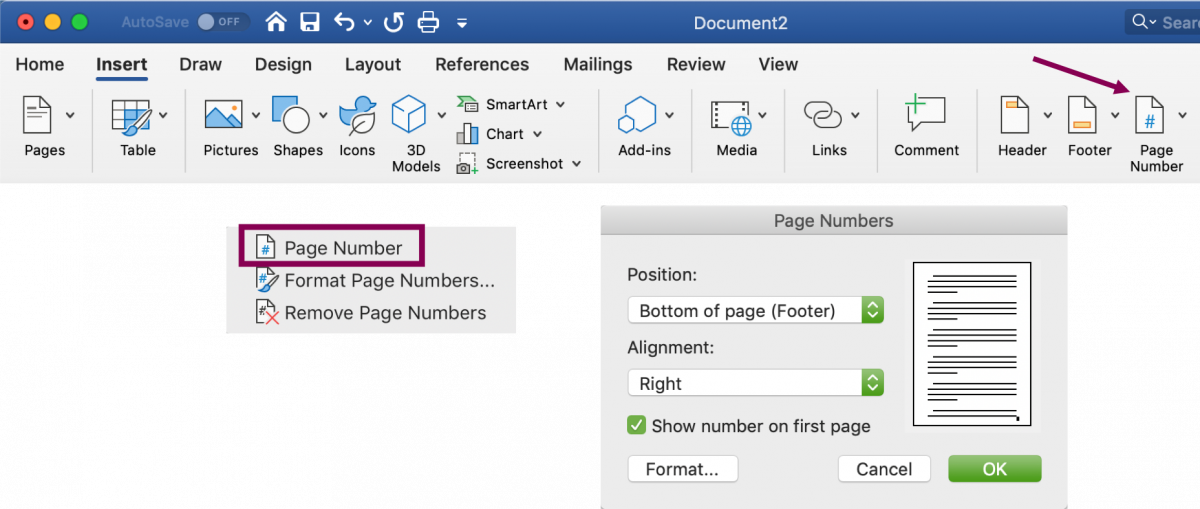

Scroll up to see that the original header is still in tact in the previous section. Check the Different first page box in the middle of the tool bar. This setting will give the first page a different header and footer from the rest of your document. Open the header by double clicking at the top of the document, or going to Insert > Header. On this tab, in the Options group, click to check the Different First Page option. The Header & Footer Tools > Design tab will appear. Click on this tab and you will see a box for "Link to Previous." Uncheck this box. To insert a header only on the first page in Word, double-click on the header section to make it active. You will notice that in the ribbon, there is now a tab called "Header and Footer" that appears right after the "Home" tab. Now that you've created a section break, go to the first page you want to change the header. Click Insert/Breaks/Section Break (Next Page).Ħ. Wherever you want your header to change, click your cursor at the end of the copy on the previous page and insert a section break, next page. Click in the header area and type your first header.ĥ. If you want to alter the way your header/footer looks, click on the tab "Document Elements" and choose from the variety of preset styles available.Ĥ. If you are cool with the default header/footer style, you can skip this step. You WILL NOT see a tab called "Headers and Footers" yet.but you will in a minute.ģ. Once your ribbon is turned on, you will see tabs (Home, Layout, Document Elements, Tables, Etc). You can modify your Header or Footer to have a different first page. If you want to vary the Layout you need to create appropriate Section Breaks, then change the specifications for the respective Sections. When editing your Header or Footer, you can add different widgets, such as page numbers, date & time, document info, or other quick parts. Replied on AugDifferent first page is a property of the Header, itself, whereas Headers/Footers & Layout specifications (margins, orientation, paper size, columns, etc.) are properties of Sections. If you create a page header (and/or footer), it will appear on every page. Odd Page Insert a section break and start a new section on an odd-numbered page. By default every Word document has at least one section, with an empty page header and footer.

This is an essential step that most instructions leave out - I've had mine turned off for years and it took me a while to figure out what it was and where it was.Ģ. Answer (1 of 8): You need to take advantage of Word’s powerful sections capabilities.
:max_bytes(150000):strip_icc()/001-make-first-page-header-footer-different-3540358-f425ef0f45944877bb05fcc06b029c50.jpg)
The first box under 'General' should say "Turn on the ribbon". In your Word preferences, you should see an icon for "Ribbon". First make sure your ribbon is turned on. 5) Click Page Number, Select Top of Page, Plain Number 3. 4) Checkmark the box Different First Page.
HOW TO CREATE DIFFERENT FIRST PAGE HEADER IN WORD 2016 HOW TO
We created a custom header in this example, but you can also create a custom footer in the same way using the “Custom Footer” button on the “Page Setup” dialog box.1. How to Create a Running head in Microsoft Word 2016: 1) Go to the first page of your Document. You’re returned to the “Page Setup” dialog box. To accept your changes and close the “Header” dialog box, click “OK”. We’re going to add the filename to the center of the header, so click in the “Center section” box and then click the “Insert File Name” button. To do so, click the “First Page Header” tab.Ĭlick in the “Left section” box, “Center section” box, or “Right section”, depending on where you want to put the content of your header. However, for our example, we’ll add different text. For the first page of your spreadsheet, you may want to leave the header blank, which is the default. The “Header” tab is where you specify the header for all the pages after the first page, which, in our example, is the page number and the total number of pages. Double click the header or footer section in page 2 to. Click on the top of a page where you want to start a new header or footer which is different to the original one (here I click on the top of the page 2), click Layout > Breaks > Next Page. Once you’ve turned on the “Different first page” option, you can customize the header for the first page of the spreadsheet and the header for the rest of the pages. Please do as follows to create different headers or footers in a Word document.


 0 kommentar(er)
0 kommentar(er)
